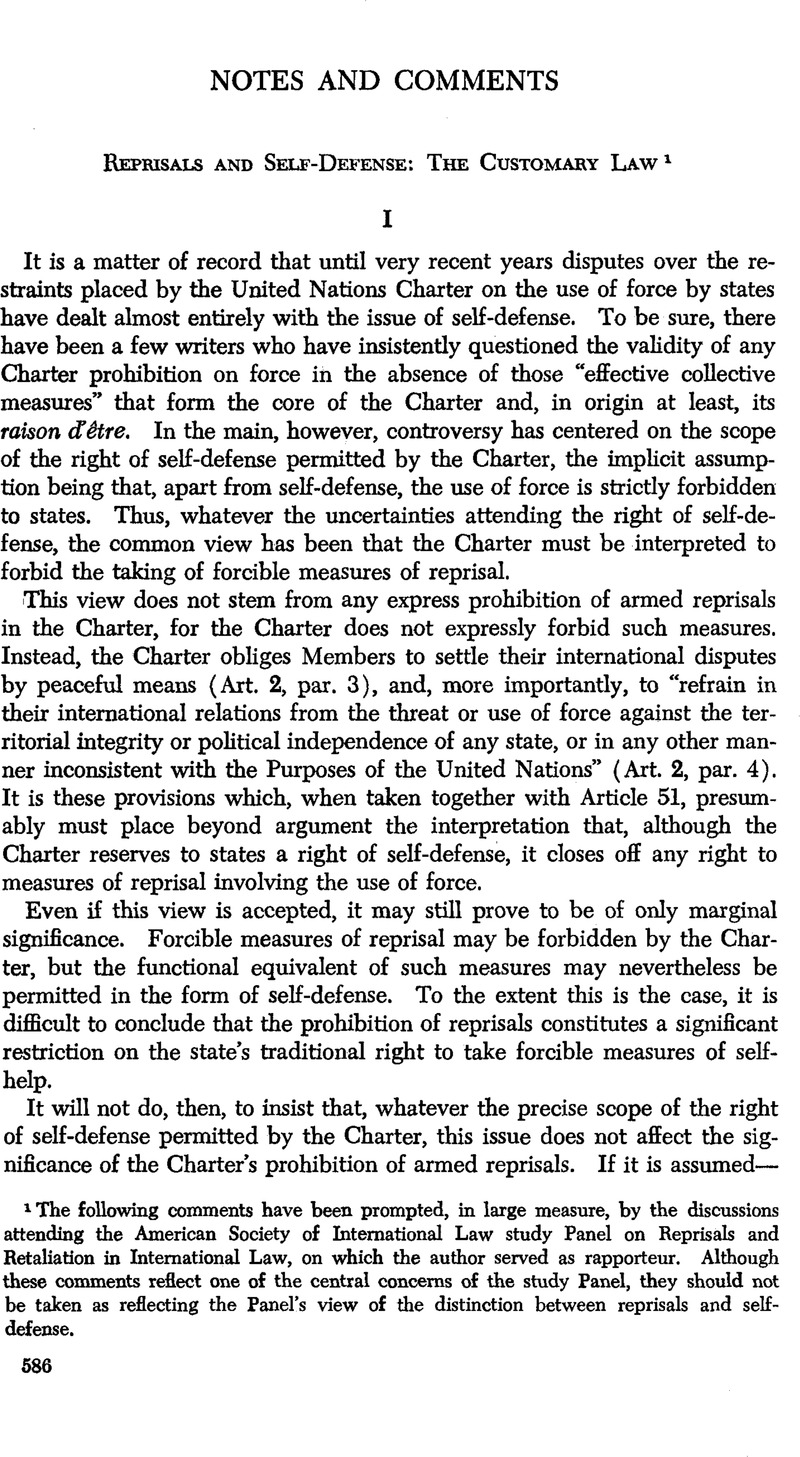Article contents
Reprisals and Self-Defense: The Customary Law
Published online by Cambridge University Press: 28 March 2017
Abstract

- Type
- Notes and Comments
- Information
- Copyright
- Copyright © American Society of International Law 1972
References
1 The following comments have been prompted, in large measure, by the discussions attending the American Society of International Law study Panel on Reprisals and Retaliation in International Law, on which the author served as rapporteur. Although these comments reflect one of the central concerns of the study Panel, they should not be taken as reflecting the Panel’s view of the distinction between reprisals and self-defense.
2 Moreover, quite apart from the indeterminate character of the right of political independence, the point must be emphasized that there is no authoritative and generally accepted statement of the rights on behalf of which self-defense may be exercised according to the customary law. Many writers extended self-defense to include the protection of nationals as well as the protection of certain economic rights. Other writers went even further. This failure to make a clear distinction between self-defense and a more general right of self-help found expression in the claims occasionally put forth by states.
3 Bowett, Derek, “Reprisals Involving Recourse to Armed Force,” 66 A.J.I.L 3 (1972)Google Scholar.
4 It is scarcely an effective response to this implicit criticism of resting so much on one arbitral judgment to point to a similar dearth of authority in the case of self-defense, unless the curious logic is followed that the absence of authority for the conditions governing the taking of reprisals is somehow compensated by the equal absence of authority for the conditions governing the exercise of self-defense. A more reasonable position, it would seem, is to concede that The Caroline case does no more to dispel the doubt and uncertainty over the exercise of self-defense than the Naulilaa arbitration does with respect to the exercise of reprisals.
5 This follows not so much from the obligation in Art. 2, par. 4, to refrain from the threat or use of force “against the territorial integrity or political independence of any state,” as it does from the further obligation not to threaten or use force “in any other manner inconsistent with the Purposes of the United Nations.” Unless territorial integrity or political independence is equated with territorial inviolability, it may be argued that forcible reprisals, like forcible measures of self-defense, cannot be directed against the territorial integrity or political independence of a state, else they would cease to be legitimate reprisals. Very different, however, is the injunction not to use force in a manner inconsistent with the Purposes of the United Nations. Since the principal purpose of the Organization is to maintain international peace and security through the taking of “effective collective measures,” it is argued that any use of force which does not have the character of a collective measure in the sense of Art. 1 of the Charter is therefore forbidden unless expressly permitted as an exception to Art. 2, par. 4. Art. 51 is the only such exception. This argument, then, can be challenged only by the position that the obligation laid down in Art. 2, par. 4, is itself dependent on the assumption that the system of collective security established by the Charter will prove effective in practice.
6 See Bowett, loc. cit. 2–10.
7 See Bowett, loc. cit. 10–17, for an excellent review.
8 For a proposed framework embodying “certain general policies concerning the use of force in periods of peace,” see Richard A. Falk, “The Beirut Raid and the International Law of Retaliation,” 63 A.J.I.L. 440–442 (1969). Although Falk’s suggested framework is intended to deal above all with terroristic acts, or guerrilla activity, it seems reasonable to apply his framework to other situations as well. A careful examination of this framework shows that it is almost equally applicable to measures of self-defense. Indeed, the principal criteria Falk lays down for reprisals only serve to reinforce the point made in the text.
- 12
- Cited by


